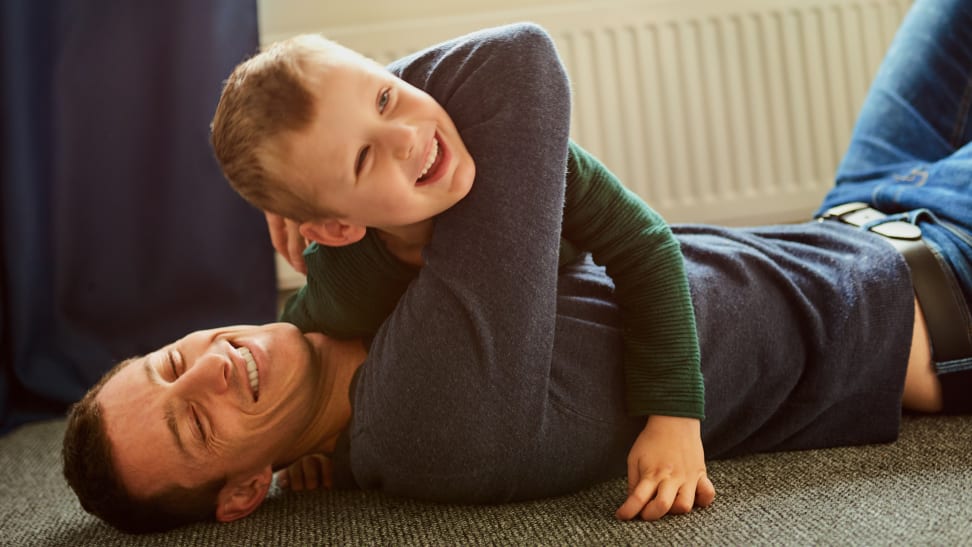 — Recommendations are independently chosen by Reviewed’s editors. Purchases you make through our links may earn us a commission.
— Recommendations are independently chosen by Reviewed’s editors. Purchases you make through our links may earn us a commission.If you've been stuck at home for the past few weeks, you may have noticed an uptick in your child's aggressive behavior. If your child has been tackling you or your partner, doing somersaults off the sofa, or broken at least one lamp or picture frame, you're not alone. Being cooped up has made all of us punchy. But what if we told you that leaning into your child's rough-play tendencies is the healthiest thing you could be doing right now?
In an era of bubble-wrap parenting, roughhousing can feel alarming, aggressive and the farthest thing from what we should be encouraging right now, but social scientists say the benefits of this kind of play significantly outweigh the risks of a few bumps and bruises. In fact, intense physical play offers a variety of surprising advantages, from increasing a child's understanding of ethical morality to improving self-regulation to increasing their IQ.
One of the most surprising components of successful roughhousing, however, is parental involvement. While scrapes between siblings rarely end well, a few minutes of play fighting or a pillow fight with parents can improve the connection that kids are so desperately pining for, and help mitigate anxiety and negative attention-seeking behaviors. If you've never roughhoused with your child before, or if you have been hesitant to do so, now is the time to give it a try.
Lawrence J. Cohen, Ph.D., the author of Playful Parenting and The Opposite of Worry and the co-author of The Art of Roughhousing, is a licensed psychologist specializing in children's play and play therapy; he argues that making time for playful, high-energy, and physical connection may be the most important thing you can do right now. "Kids are missing their friends and they miss being outside," says Cohen, adding that if you're experiencing a lot of negative behaviors right now rough and tumble play is the first thing he'd recommend. "I’d make time for that even before online learning, which can feel really disconnected. We are a species that thrives on connection, and kids are suddenly living this incredibly disconnected existence. They can catch up on learning but you can’t catch up on connection."
Why and how to roughhouse
1. Roughhousing builds empathy
Because rough play is high stakes, it's an opportunity for kids to acknowledge how to create a safe environment for others—thus building an empathetic approach to play. A tip for building empathy through rough play is to enter into every play session by having your child take responsibility for both of your safety.
Roughhousing doesn't mean encouraging aggressive behavior: Set up the boundaries before you start. For example, tell your kids you are taking off your glasses or jewelry first and ask them to tell you why. They should be answering, "So you won't get hurt" reminding them daily that this is play and no one should walk away bleeding. Ask them to find a place in the room where it's safe for everyone. When they learn to take responsibility for other people's safety and well-being, they become accustomed to acknowledging it.
Suggested play: Pillow fight
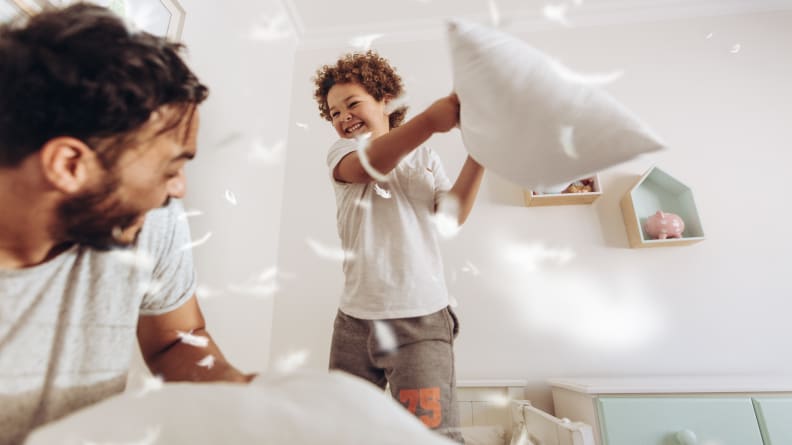
Pillow fights are a fun and pain free way to roughhouse.
Leah Dwin of Move2Improve in Carlsbad, California, a certified Pilates instructor, Cortical Field Re-education practitioner, cranial sacral therapist, and a mother of two, is a huge proponent of the power of pillow fights. She recommends always having a safe zone for family members to retreat to. "When we have pillow fights, which I love, everyone picks a space that is their home base. When they are in their home base, no one is to touch them and they can feel that safety. A pillow fight is a great way to get out aggression, fear, and uncertainty and their home base is a place of calm and safety."
2. It's an organic way to learn about consent
Part of rough and tumble play is learning when to stop. When kids are given the opportunity to play rough they learn in a real and relatable situation what "stop" and "no" means. According to Thanna Vickerman, Certified Peaceful Parent Coach & Educator kids learn emotional intelligence through watching facial expressions and body language. "We parents must model stopping when asked, stopping when asked, stopping when asked," she says.
While parents might think it is funny to pretend that they didn’t hear a child say 'stop', modeling the correct and respectful response teaches our kids to do the same. Vickerman says the key in teaching consent is to "follow the giggles," as she puts it. It should all be about laughter—once the laughter stops, change gears.
Suggested play: Tickle fight
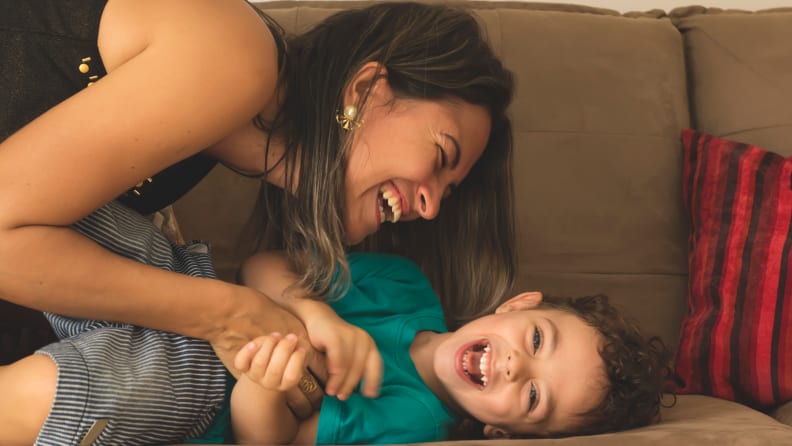
Keep tickling until they tell you to stop.
Vickerman says tickle fights are a great way to practice consent and says everyone should clearly listen to "stop," "go," and "start." "Someone can only be tickled when they say 'yes' and as soon as they say 'stop', tickling stops on a dime," she says. She stresses the importance of parents to model stopping immediately and respectfully when children ask them to.
If your child doesn't want to tickle fight, Vickerman recommends play where you chase them around the house pretending they are invisible. "It allows for boundaries when a child doesn't feel like being touched, but creates connection and it really gets them giggling."
3. Playing rough increases calm
Have you ever tried to get your child to do deep breathing as a way to calm down during a fit of anger or right before it's time to do homework? It's like putting a cork on a fully shaken bottle of carbonation. It can be impractical to expect a child to calm their minds and bodies when emotions are high. While mindfulness practices are a powerful tool, they cannot be the only tool in the toolbox. "Children, especially, need to have their innate physicality respected and understood—sitting quietly is not always going to be the road to peace. Wild roughhousing may get you there faster, even if that seems like a contradiction," says Cohen.
The next time your child gets worked up over something they can't control or has a meltdown, instead of asking them to calm their breath, ask them if they want to have a wrestle or pillow fight so they can blow off some steam before they are asked to cool their jets.
Suggested play: Stage fighting
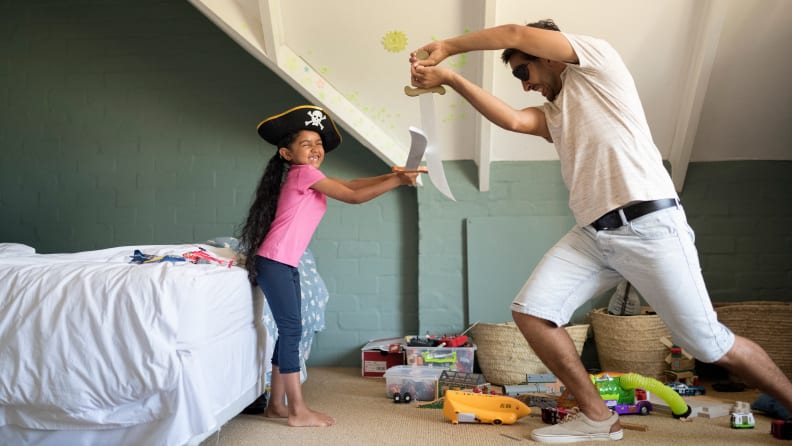
Get out the props and start stage fighting.
Cohen says he loves this game because it feels aggressive and silly to a kid, but it's really all about control. Basically mimic any moves that stuntmen do with a completely staged fight with your kid. Kids can karate chop and sword-fight out all of their energy while being in complete control of when they fall. "Kids love this because it's both completely silly and gives them complete control all at the same time," says Cohen.
5. It boosts resilience
Being able to bounce back from stress, challenge, or adversity are vital coping skills. When children are resilient, they are braver, more curious, more adaptable, and more able to extend their reach into the world. Research tells us that the ability to bounce back from failures and adapt to unpredictable situations will help your kids reach their full potential and live happier lives as adults.
Roughhousing teaches kids to quickly adapt to unpredictable situations. According to Vickerman the unpredictable nature of roughhousing can increase the connections between neurons in the cerebral cortex, which in turn contributes to behavioral flexibility. Learning how deal with sudden changes while engaging in the frenetic energy of rough play trains a child's mind to cope with unexpected bumps in the road when they’re out in the real world.
Suggested play: Force-field
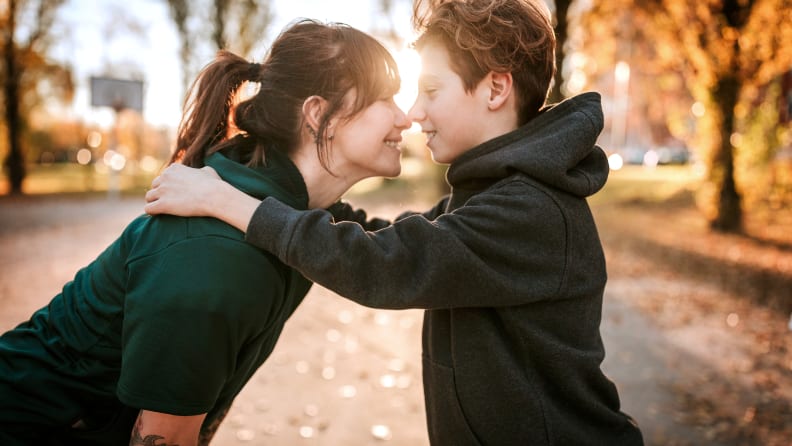
Connect with your kids by getting down on their level.
This is a multi-step game that Cohen recommends. Players have to adapt and re-adapt through each step and really hone in and listen. Get face-to-face with your child, which may mean kneeling on the floor. The first step is to try to feel the "force" or "force-field" between the two of you. After everyone feels like they have that, practice pushing each other without touching and have your child really pay attention to how and where you are pushing them—and you do the same. The third step is to touch hands and gradually increase and match each other's pressure. Both sides should be pushing really hard but not going anywhere. The last step is to push hard and try to get each other off balance.
6. It makes kids smarter
Because rough play is, by nature, rapid-fire, it requires that kids hone their attention to detail. "Because kids have to pay attention and switch tasks quickly it helps sharpen self-regulatory behaviors that are essential for learning—whether that be at school, or through distance learning.
Cohen recommends you do rough play in short bursts to help hone impulse control, sharpen attention spans, and keep everyone feeling safe.
"Kids need to build up to having well-honed impulse control," he says. Cohen always recommends breaking things up into minute segments—whether it be pillow fights to freeze-dancing. "It makes things safer and allows for check-ins, and it keeps players sharp and connected. Short bursts are key in rough play."
Suggested play: Animal charades

Get the whole family in on the fun with animal charades.
At Dwin's house they put out three cups marked "animal", "activity" and "something silly." Everyone writes down an animal, an activity (such as ice skating, basketball, or dance) and something silly (such as hopping on one foot with your eyes closed or doing everything backwards) and puts them in the marked cups. When the person gets up to do charades they pick one piece of paper from each cup. When you have a kid being a monkey playing basketball while flossing it's certain to inspire some giggles. Parents can tip the scales by adding your own ideas. Midway through randomly shout out "freeze"—catching a kid acting out their character mid-way makes things even sillier and forces them to reset and rethink what they are doing.
In the end all that tumbling and tackling helps develop strength, flexibility, and complex motor learning, in addition to concentration, cardiovascular fitness, and coordination. And there is one more surprising bonus: Roughhousing makes parenting easier. It helps mitigate negative, aggressive, and attention-seeking behavior by providing a positive outlet for the big and scary feelings kids are having. On the surface roughhousing may read simply as crazy, rowdy play, but underneath it can help lay solid groundwork for how children react to failures and obstacles, and it gives an opportunity for us to bond with them, and listen to them through physical play, during their most trying times.


